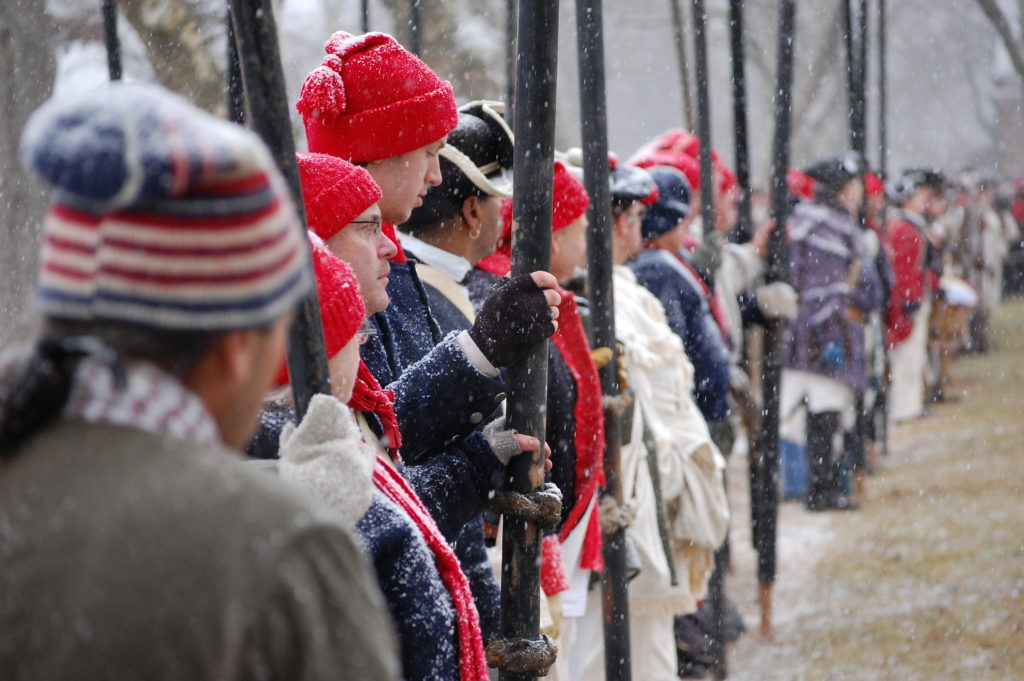By June 1775, the Intolerable Acts, also known as the Coercive Acts, had pushed a port town a little more than 300 miles north of Washington Crossing to the brink.
Rendered unemployed and angry by the strict trade measures imposed by British Parliament, virtually every able-bodied man in Marblehead, Massachusetts, rallied to fight against their common enemy. (Accounts vary significantly as to exactly how many men the group included at its inception.)
The Origins of the Marbleheaders
By the next year, the modest militia had become the 14th Continental Regiment of George Washington’s army—and one of the few integrated regiments in the entire army.
Slavery existed in New England but looked different than it did in the south. In Massachusetts at the time, some slaves challenged it in court to varying degrees of success. Maritime culture in particular tended to be much more tolerant of racial diversity than the rest of the country, which made Marblehead an attractive place to settle for the Black sailors who often joined the crews who sailed back and forth between the port town and the Caribbean, according to Frank Lyons, who portrays Col. John Glover, the regiment’s leader, at Washington Crossing Historic Park reenactments. (Glover was promoted to the rank of brigadier general in February 1777.)
Washington, who was a slave owner and initially opposed enlisting Black men in the Continental Army, accepted the Marbleheaders. Early on, the regiment developed a reputation as undaunted, dependable soldiers—mariners, really—who were uniquely qualified to deal with the adverse conditions that would factor into some of the most pivotal battles in the months ahead. Gaps of information in the muster rolls make it difficult to determine the precise number of Black soldiers who fought for the Marblehead militia at any point, Lyons says.
The Marbleheaders and the Crossing
In August 1776, Washington and the Continental Army were in tatters after a furious siege by the British in New York. But they lived to fight another day largely because the Marbleheaders rowed 9,000 soldiers, along with their horses and artillery, across the East River to the relative safety of Manhattan under the cover of darkness.
In October, British General William Howe and 4,000 soldiers landed at Throg’s Neck, five miles from King’s Bridge, the major crossing from Manhattan, with the intent to trap Washington and his men. After a week of bad weather, the British relocated to Pell’s Point, three miles north of Throg’s Neck. But Glover and the Marbleheaders were waiting for them. While they engaged the British, Washington withdrew his troops and regrouped in White Plains.
When the Marbleheaders arrived in Bucks County around December 22, 1776, Washington asked Glover if his regiment would help take the lead, along with Captain Joseph Moulder’s Pennsylvania artillery company, in getting him and his troops across the river on Christmas night.
Glover accepted, even though he was likely wary of the challenge, Lyons says.
On December 24, the Marbleheaders began collecting all the Durham boats and ferries that had been docked up and down the river’s Pennsylvania banks to prevent the British from crossing. As they did so, they also may have tested the river conditions, Lyons says.
Around 6:00 PM on Christmas night, the Marbleheaders began shuttling soldiers, artillery, and horses across the river. The process would continue into the early morning, much of it in the face of a relentless Nor’easter.
After the crossing, the army split into two. The Marbleheaders were positioned near the front of General John Sullivan’s column that would attack Trenton from the southwest. Glover and his men blocked the bridge across Assunpink Creek, preventing the Hessian soldiers from escaping, Lyons says.
After the battle, the Marbleheaders led a significant portion of the return crossing, which was more fragmented than the initial effort and even slower-going with about 900 Hessian prisoners in tow.
“In all likelihood, the Marbleheaders didn’t sleep for at least three nights,” Lyons says. “They truly bore the brunt of that historic effort.”


